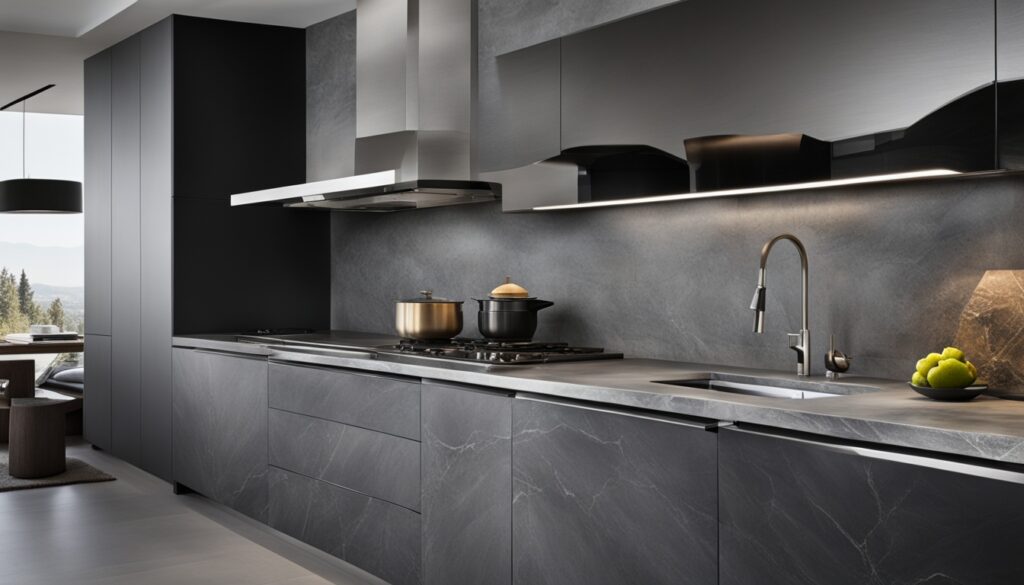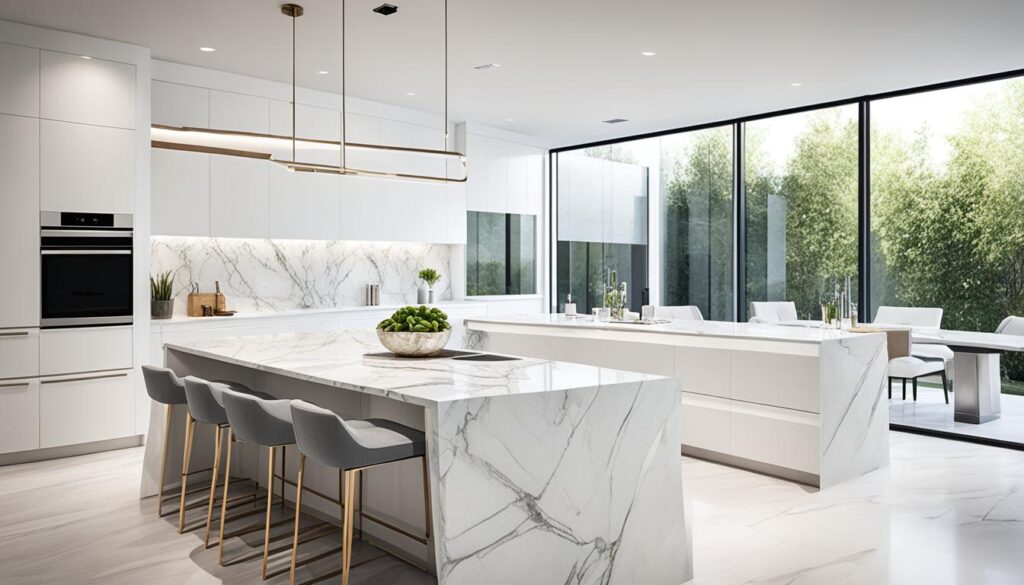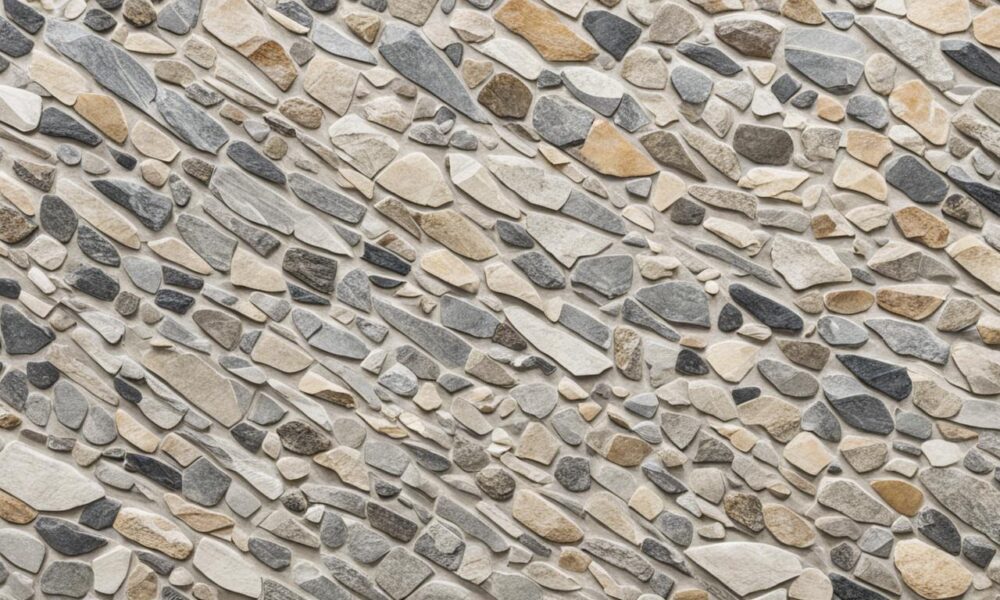Natural Stone Comparison Guide for Your Home
Choosing natural stone countertops can be tough because there are so many beautiful options. The Rock Doctor’s natural stone comparison guide makes it easier. It covers important details about the best stones for countertops. Homeowners can explore the pros and cons of granite, quartzite, and marble. This helps them pick what fits their needs, style, and budget.
Key Takeaways
- Granite offers nearly 3,000 different colors and types for countertops1
- Quartzite is harder than quartz and naturally resistant to heat and stains1
- Marble countertops come in various neutral colors, adding elegance to any space1
- Limestone mimics marble’s veiny patterns, providing a versatile aesthetic1
- Slate is versatile, offering different shades that suit various decor styles1
- Soapstone is non-porous and resistant to stains and bacteria, simplifying maintenance1
- Travertine tiles are eco-friendly due to their minimal manufacturing requirements1
Granite: Durability and Beauty
Granite is known for its great strength and natural beauty. This stone formed over 300 million years ago and stands as one of Earth’s oldest and most durable materials2. With around 3,000 varieties, granite countertops showcase a unique look and a vast color range. This makes them a top pick for people improving their homes.
Pros of Using Granite
Granite countertops won’t easily chip, scratch, or break, making them very tough3. This toughness is perfect for areas in homes that get a lot of use. Also, granite can resist heat, meaning it won’t lose its color if it gets really hot3. These countertops can last more than 30 years with the right care, raising a home’s value4.
- Durability: Granite is one of the toughest natural stones, along with quartzite2.
- Resale Value: Granite countertops can make a home more valuable.
Cons of Using Granite
However, granite isn’t perfect. Since it’s porous, it needs frequent care including sealant applications to avoid water damage and stains3. Plus, the cost of granite counters can be high, ranging from $10 to $75 for each square foot3. Choosing granite means weighing your budget against wanting a strong, attractive surface.
- Porosity: To prevent moisture damage, it needs regular sealing with a natural stone sealant3.
- Cost: The price of granite countertops varies based on quality and design3.
For those seeking beauty and durability, granite is a top choice. It’s a lasting investment if you’re ready for regular upkeep.
Quartzite: The Marble Look-Alike
Quartzite is gaining fans for its elegant look and toughness. It’s made from sandstone and quartz. During its formation, it transforms into a hard, crystal structure. Quartzite is tougher than marble. On the Mohs scale, it gets a 7, while marble scores about 35. This means it can handle scratches and wear better. It’s perfect for busy spots like kitchens.
Quartzite countertops stand out because they resist heat and stains better than marble2. You’ll need to seal them regularly because they can soak up liquids. But, they don’t get damaged easily by acidic substances. Plus, they stay cool under high temperatures6. They’re also great at maintaining their color, even in sunlight.
They look bright and have beautiful veins, making them a gorgeous choice for homes. Due to its strength, quartzite is becoming a favorite for both kitchen and bathroom counters6. However, it’s pricier than granite. This can make it a stretch for some budgets.
| Material | Hardness | Heat Resistance | Stain Resistance | Cost |
|---|---|---|---|---|
| Quartzite | Very Hard | High | High | High |
| Marble | Soft | Medium | Low | High |
| Granite | Hard | High | Medium | Variable |
If you want luxury that lasts, think about quartzite countertops. They mix beauty with toughness in a way no other stone does. Choosing quartzite means you get a marble-like surface that stands up to life’s bumps and spills.
Marble: Classic Elegance
Marble is seen as the height of luxury. It’s cherished for adding a cool, elegant touch to kitchens and bathrooms. Its waterproof and heatproof features, along with the distinct veining, makes each piece stand out. Also, it can increase the value of your property. It’s available in different shades and patterns. This is great for bakers and those who love a sophisticated style7.
Pros of Using Marble
Marble brings unmatched beauty to any space. Its natural cool qualities are perfect for baking. Plus, it’s heatproof, so hot pots won’t harm it. Each piece has unique veins, ensuring no two are alike7.
Cons of Using Marble
However, marble needs a lot of care. It scratches and etches more easily than granite. It fits best in places that aren’t used much, like bathroom vanities8.
Also, marble must be sealed often to avoid stains. This extra step can be costly8. Since marble is heavy, you’ll need pros to install it. This can make the price go up, which isn’t ideal for everyone7.
Marble is a top choice for bringing luxury to a home. Yet, its high price and upkeep are downsides. By looking at other stones, you can choose what’s best for your home. Think about what’s most important: looks, strength, or maintenance87.
| Stone Type | Durability | Maintenance | Recommended Use |
|---|---|---|---|
| Marble | Softer, prone to scratches | High, requires frequent sealing | Bathrooms, low-traffic areas |
| Granite | Highly resistant to scratches and heat | Moderate, requires sealing | Kitchens, high-traffic areas |
| Quartzite | Exceptionally durable | Low, minimal sealing required | Kitchens, bathrooms, high-traffic areas |
Limestone: Versatility and Aesthetic Appeal
Finding the right natural stone for your home matters a lot. Limestone is a top choice for its looks and useful qualities. It mainly forms in shallow parts of the ocean, which adds to its charm in designs9. With soft, understated colors like beige and cream, limestone makes any space look beautiful8.
Pros of Using Limestone
Limestone stands out for its strength and ability to resist weather, lasting a long time9. It can look like marble and fits well with many interior styles. Those who prefer an earthy and sophisticated style will love limestone countertops. Plus, it’s often more affordable than other stones, helping save on costs9.
Cons of Using Limestone
Limestone is stunning but has its downsides. Its softness means it needs care to avoid damage8. Being softer than granite, it’s not the best for busy places. Its limited colors might not suit everyone’s or every home’s style. Still, many find its beauty worth the extra care.
It’s crucial to compare stones when planning home improvements. Each stone brings something special to your project. It ensures you choose wisely for both looks and function. Limestone offers a blend of natural appeal and lasting quality. This makes it an appealing choice for many.
Slate: Affordable and Stylish
Slate countertops are a great choice because they are affordable and look good. They don’t stain and can handle heat well, perfect for active kitchens. The unique soft-matte look of slate gets better with oil, fitting well with simple designs.
Features of Slate
Slate comes in colors from grays to bright pinks, purples, or greens. It’s a good choice for different room styles. It’s strong, can take a lot of use, and is easy to keep looking good.
Pros and Cons
Slate countertops are good because they don’t cost too much and don’t get stained or damaged by heat easily. It’s a smart pick for houses that want stylish yet useful counters. But, the sharp edges of slate can be a hazard, and it can get scratched. Luckily, fixing scratches on slate is usually simple, making it a reliable choice for kitchens.
Soapstone: Antique Charm with Modern Functionality
Soapstone countertops offer a mix of old-world charm and modern use. This makes them a favorite for homeowners updating their homes. They have a natural anti-bacterial feature and don’t soak up liquids or hold bacteria. This is great for kitchens10. Since they don’t stain or burn easily, they last a long time in any home10.
Soapstone looks unique because of its smooth veining and rich talc content. It can improve the look of both old and new homes. You can find it in colors like black, white, grey, green, and blue. This means it can fit any style and be the center of attention in kitchens or bathrooms10. Black adds classic elegance, while white feels light and airy. Grey matches well with many designs10. Green and blue soapstone add a pop of color and beautiful veins10.

Soapstone changes look naturally over time. Regular oiling brings out its color and adds charm, making every countertop one-of-a-kind10. Its softness is also good for making detailed designs. This has been valued in art and crafts for hundreds of years11. Today, artists still use soapstone to create unique pieces, mixing old skills with new ideas11.
In the end, soapstone is a top choice for home upgrades. Its ability to fend off bacteria and resist stains and heat makes it useful and pretty. It fits well in any room, combining looks and practicality.
Travertine: Creating an Old-World Vibe
Travertine countertops are a top pick for those looking to add a classic touch. This eco-friendly stone is not just pretty but also kind to the planet. Its making requires less energy1. The stone’s warm, creamy look makes any space feel welcoming.
Pros of Using Travertine
Travertine stands out for its beauty and eco-friendliness. It’s made with less impact on the environment1. Its creamy colors offer a timeless style, moving away from the typical greys and whites12. You can get it as slabs or tiles, fitting any design need.
Cons of Using Travertine
However, travertine needs a lot of care. It must be sealed regularly to block moisture and stains12. Its pink beige tones might not fit with modern looks, requiring good color picks12. Though you can sand away imperfections, its upkeep might be too much for some.
Quartz: Engineered Elegance
Quartz countertops mix natural quartz with resins and pigments. This creates a tough and flexible material13. As an engineered stone, quartz is smooth and resistant to stains. It’s perfect for kitchens that see a lot of action14. The resin content makes these countertops stain repellent and keeps the color consistent14.
Quartz is a loved choice for its wide variety of colors and patterns13. Compared to granite, it barely needs any upkeep. Granite requires a yearly seal, unlike quartz14. Though quartz is sturdy and not easily damaged, it can’t withstand high heat14. It’s essential to use heat pads to protect it from hot items14.
The resin in quartz can get scratches, but polishing easily fixes them14. Quartz countertops are charming and budget-friendly. They are a top pick for many homeowners.

Comparing Different Types of Natural Stone for Your Home
Choosing the right natural stone requires knowing a few key points. Stones differ in hardness, how much care they need, and looks. Granite is tough and great for kitchens since it resists heat and scratches15. Limestone, though not as hard, works well for floors and around fireplaces because of its beauty15. Sandstone offers warm colors and is perfect for outdoor use, like paths and exterior walls15.
Factors to Consider
Deciding on granite, limestone, or sandstone comes down to their traits. Granite is low-maintenance, needing just occasional sealing to stay beautiful15. On the flip side, limestone and sandstone are more porous, requiring more care and sealing15. Apart from upkeep, consider cost. Granite costs more due to its hardness and color variety, unlike the more affordable limestone and sandstone15.
Maintaining Natural Stone
Natural stone’s looks and lifespan largely depend on upkeep. Granite is simpler to maintain, fitting for active homes15. Limestone and sandstone, however, need careful sealing and cleaning because they are more porous15. Those ready to put in the work will find these stones add unique beauty to both indoors and outdoors. Choosing stone is about balancing care needs with how you want your home to look.
Source Links
- https://rockdoctor.com/natural-stone-countertop-materials-comparison-2021/
- https://www.hardrockstoneworks.com/stone/compare-stone
- https://www.msisurfaces.com/blogs/post/2023/02/28/popular-natural-stone-countertops-granite-vs-quartzite-vs-marble.aspx
- https://www.gmswerks.com/blog/article/stone-showdown-comparing-the-lifespan-of-different-stone-countertop-materials
- https://www.tenax4you.com/quartzite-marble-compared-s/2230.htm
- https://www.patticakewagner.com/comparing-quartzite-and-porcelain-as-a-marble-alternative/
- https://stonecenters.com/blog/types-of-natural-stone-for-house-exterior
- https://rockdoctor.com/how-choose-natural-stone-for-home/
- https://stonecenters.com/blog/sandstone-vs-limestone-key-differences
- https://www.tureks.com/farmhouse-kitchen-designs-featuring-soapstone-countertops/
- https://www.dilwana.com/blogs/african-crafts/soapstone-sculpting-natures-beauty-into-art
- https://mariakillam.com/timeless-kitchen-travertine-before-after/
- https://www.work-tops.com/a/expert/natural-stone-vs-engineered-stone
- https://www.rdmarble.com/blog/kitchen-countertops/natural-vs-engineered-quartz-countertops-for-your-kitchen/
- https://www.stonearch.ca/blog/comparing-types-of-natural-stone-granite-vs-limestone-vs-sandstone



